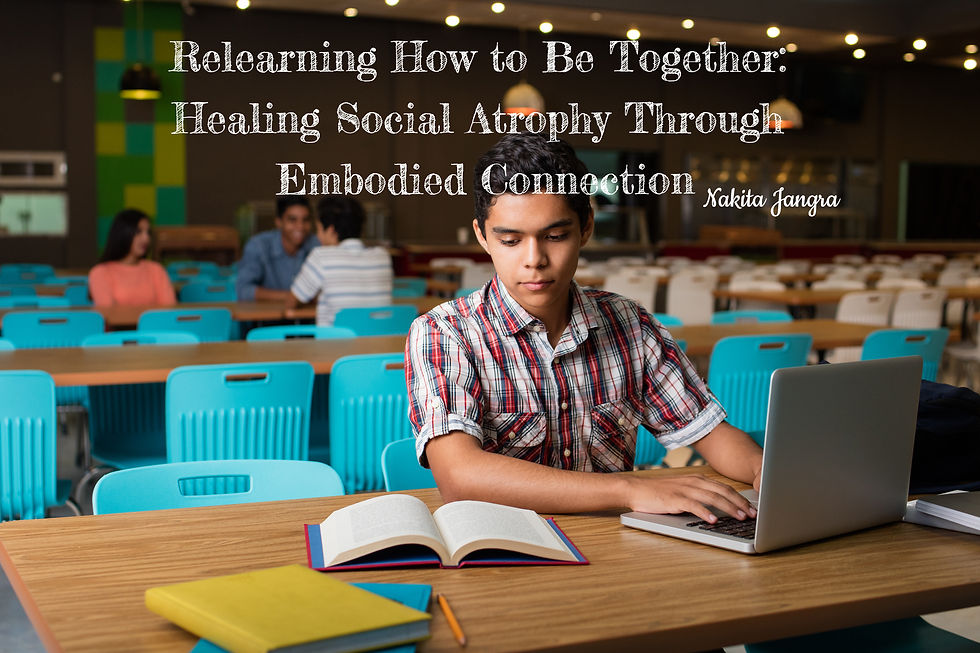Relearning How to Be Together: Healing Social Atrophy Through Embodied Connection
- nakitajangra
- Aug 5
- 3 min read
By Nakita Jangra, Psychotherapist

A Culture Out of Practice
Something subtle but significant is happening in the therapy room—and beyond. More people are reporting difficulty connecting in person, discomfort with eye contact, awkwardness in social settings, and a vague but persistent feeling of disconnection. After years of digital communication, pandemic isolation, and the normalization of screens as our primary social space, many of us are experiencing what I call social atrophy. This isn’t a moral failing or a personal weakness. It’s a natural consequence of living in a world that’s become less embodied, less relational, and less tolerant of emotional nuance. The good news? Like any muscle, our social capacity can be rebuilt—with presence, intention, and compassion.
What Is Social Atrophy?
Social atrophy is the quiet erosion of our relational confidence and emotional fluency. It’s the anxiety that creeps in before a phone call, the hesitation around physical closeness, the impulse to text instead of speak. It’s the loss of subtle cues—facial expressions, tone, pauses—that can’t be replicated online. From a nervous system perspective, many people are stuck in protective states. When we’re chronically online, disconnected from touch and real-time interaction, our capacity for co-regulation decreases. We become more easily dysregulated in social settings, often without understanding why. Clients describe it like this: 'I want to connect, but I freeze.' Or: 'I used to feel comfortable in groups—now I’m exhausted after five minutes.' These aren’t just psychological reactions—they’re physiological ones.
The Limits of Digital Connection
We were promised that technology would bring us closer. And in some ways, it has. But proximity isn’t the same as intimacy. While texts, DMs, and emojis can simulate connection, they don’t engage our full relational systems. True connection is multisensory. It involves vocal tone, body language, eye contact, breath patterns. These are essential elements of co-regulation—our nervous systems syncing with one another in real time. Without them, we’re left with approximations. It’s like being fed digital breadcrumbs when what we really need is a meal.
Therapy as Relational Rehearsal
One of the most powerful aspects of therapy—especially from a psychosynthesis and somatic perspective—is its ability to serve as a rehearsal space for being in relationship. Clients often say, 'This is the only place where I feel like I can just be myself.' That’s not accidental. The therapeutic relationship is intentionally structured to foster safety, honesty, and emotional presence. In session, we practice:- Making and maintaining eye contact without collapsing or dissociating- Naming feelings in the moment, even when they’re uncomfortable- Experiencing emotional mirroring that’s attuned, not performative- Repairing ruptures when misunderstandings occur. These micro-moments of connection rewire the nervous system. They show us that presence is possible—and safe.
Practices to Rebuild Connection
Healing social atrophy doesn’t require dramatic steps. Like physical therapy, it’s about gentle, consistent practice. Here are a few ways clients—and all of us—can begin to re-engage:- Practice eye contact in safe settings, even if it feels awkward- Initiate short in-person conversations—at the café, in your neighborhood, with coworkers- Notice your body in social situations: breath, posture, tension- Allow pauses in conversation without rushing to fill the silence- Name your discomfort: 'I’m feeling a bit rusty at this'—authenticity builds connectionThink of these as relational reps. Not to perform, but to rebuild. Like warming up a long-forgotten muscle, the strength comes slowly—but it comes.
Coming Back to One Another
We are relational creatures. We thrive not through perfection but through presence. The past few years have changed the way we connect—but they haven’t erased our need for attunement, for being seen, and for feeling safe in another’s company. Therapy offers a space to remember what connection feels like. And in our wider lives, we can carry this remembering forward. One moment of presence at a time. Because healing the social isn’t just about what we say—it’s about how we’re willing to be with one another, again.


Very insightful viewpoints on the social hangovers of the pandemic. Recognising these effects in ourselves and our loved ones is the first stage of trying to rebuild these vital connections. A great read, as always from the author.